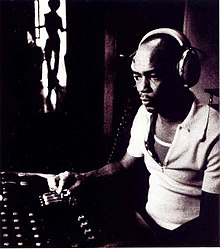King Tubby
| King Tubby | |
|---|---|
 |
|
| Background information | |
| Birth name | Osbourne Ruddock |
| Born | 28 January 1941 |
| Origin | Kingston, Jamaica |
| Died | 6 February 1989 (aged 48) Kingston, Jamaica |
| Genres | Reggae, dub |
| Occupation(s) | Sound engineer, producer |
| Years active | 1968–1989 |
| Labels | Firehouse, Kingston 11, Waterhouse, Taurus |
Osbourne Ruddock, (28 January 1941 – 6 February 1989) better known as King Tubby, was a Jamaican electronics and sound engineer, known primarily for his influence on the development of dub in the 1960s and 1970s.
Tubby's innovative studio work, which saw him elevate the role of the mixing engineer to a creative fame previously only reserved for composers and musicians, would prove to be influential across many genres of popular music. He is often cited as the inventor of the concept of the remix, and so may be seen as a direct antecedent of much dance and electronic music production. Singer Mikey Dread stated, "King Tubby truly understood sound in a scientific sense. He knew how the circuits worked and what the electrons did. That's why he could do what he did".
King Tubby's first interaction with the music industry came in the late 1950s with the rising popularity of Jamaican sound systems, which were to be found all over Kingston and which were developing into enterprising businesses. As a talented radio repairman, Tubby soon found himself in great demand by most of the major sound systems of Kingston, as the tropical weather of the Caribbean island (often combined with sabotage by rival sound system owners) led to malfunctions and equipment failure. Tubby owned an electrical repair shop on Drumalie Avenue, Kingston, that fixed televisions and radios. It was here that he built large amplifiers for the local sound systems. In 1961-62, he built his own radio transmitter and briefly ran a pirate radio station playing ska and rhythm and blues which he soon shut down when he heard that the police were looking for the perpetrators. Tubby would eventually form his own sound system, Tubby's Hometown Hi-Fi, in 1968. It became a crowd favourite due to the high quality sound of his equipment, exclusive releases and Tubby's own echo and reverb sound effects, at that point something of a novelty.
Tubby began working as a disc cutter for producer Duke Reid in 1968. Reid, one of the major figures in early Jamaican music alongside rival Clement "Coxsone" Dodd, ran Treasure Isle studios, one of Jamaica's first independent production houses, and was a key producer of ska, rocksteady and eventually reggae recordings. Before dub, most Jamaican 45s featured an instrumental version of the main song on the flipside, which was called the "version". When Tubby was asked to produce versions of songs for sound system MCs or toasters, Tubby initially worked to remove the vocal tracks with the faders on Reid's mixing desk, but soon discovered that the various instrumental tracks could be accentuated, reworked and emphasised through the settings on the mixer and primitive early effects units. In time, Tubby began to create wholly new pieces of music by shifting the emphasis in the instrumentals, adding sounds and removing others and adding various special effects, like extreme delays, echoes, reverb and phase effects. Partly due to the popularity of these early remixes, in 1971, Tubby's soundsystem consolidated its position as one of the most popular in Kingston and Tubby decided to open a studio of his own in Waterhouse in 1971, initially using a 4-track mixer purchased from Byron Lee's Dynamic studio.
...
Wikipedia
